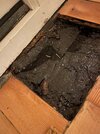Thanks JohnD, I appreciate the time you’re taking here.

That photo is right now, I’d not noticed the internal walls on the first picture if im honest but from the outside the wall itself looks damp and there was previously a green house there.
Picture before any work was done

The drain pipe you can see has been taken below ground into the drain as it was previously overflowing a lot and the water (rain water too) would just sit on top of the patio.
That photo is right now, I’d not noticed the internal walls on the first picture if im honest but from the outside the wall itself looks damp and there was previously a green house there.
Picture before any work was done
The drain pipe you can see has been taken below ground into the drain as it was previously overflowing a lot and the water (rain water too) would just sit on top of the patio.


